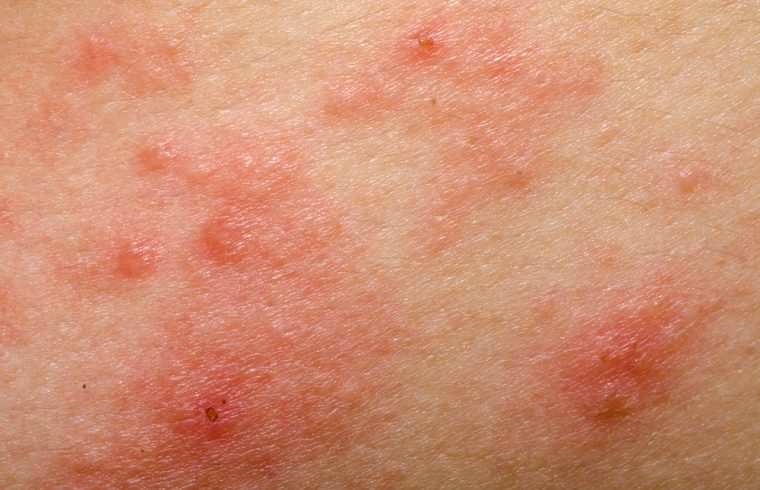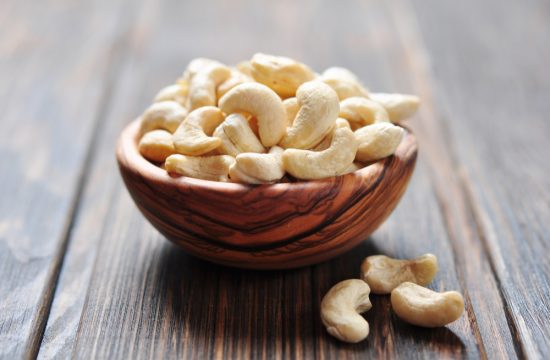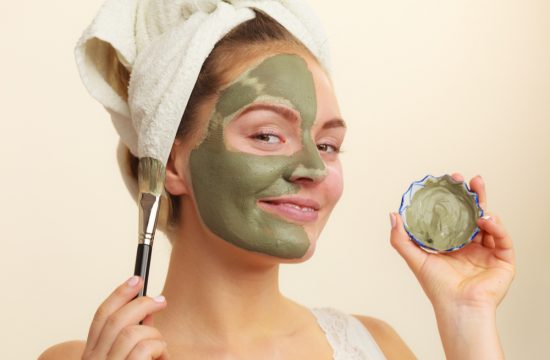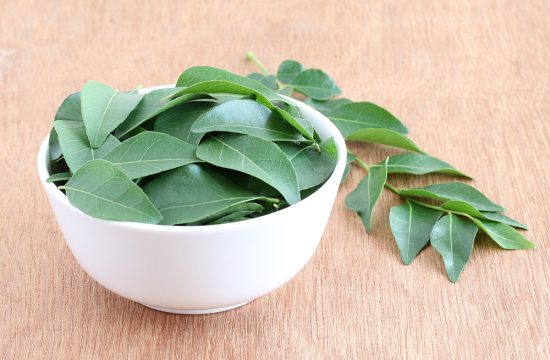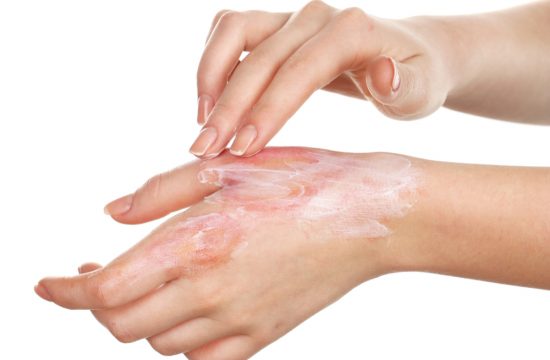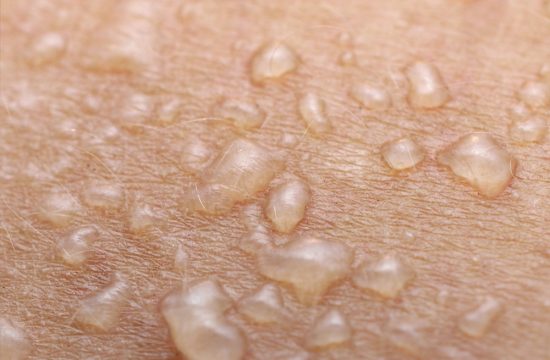A skin rash is a change in the color, appearance, or texture of the skin. It may be localized in one part of the body, or affect the whole body. Rashes may cause the skin to change color, itch, become warm, bumpy, chapped, dry, cracked or blistered, swell, and may be painful. A skin rash can be caused by various reasons.
So here are some common skin rashes you should be aware of:
1. Eczema
Also known as dermatitis, it is a group of skin disease where inflammatory rashes occur over the skin. However, it can vary from being a simple red itchy patch to fluid filled painful blisters that cover the entire body surface. Let us have a look at each of them.
Atopic dermatitis
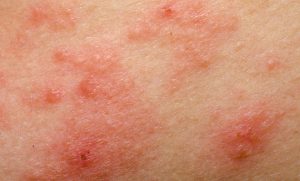
With more than 10 million cases of atopic dermatitis being reported every year, it is the most common type of skin rash. It occurs, most characteristically, on the arms and behind the knees and can also spread over other parts of the body. Usually red, itchy and scaly rashes develop in early childhood.
Cause: Common allergens may trigger the immune system of a person that activates the gene, thereby, resulting in the occurrence of its symptoms. Any prior occurrence in the family history increases the chances of its occurrence in subsequent generations.
Seborrheic Dermatitis
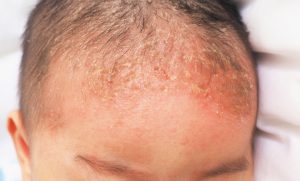
Scaly patches and red skin occur over the upper part of the body including face, chest, back, and scalp (causing dandruff). General personal care and use of medicated skin products may help ease the problem.
Cause: When skin produces huge amounts of sebum, subsequent growth of microorganisms over the affected areas of skin result in redness and scaly patches.
Dyshidrotic dermatitis
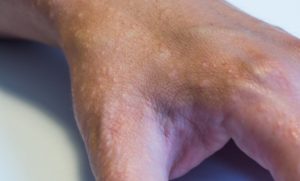
Another common class of eczema, which cannot be cured (treatments may ease the symptoms though). It is characterized by the occurrence of small, fluid-filled, itchy rashes on hands and feet, particularly palms and fingers.
Cause: Common allergens like hay fever may trigger the response.
Neurodermatitis
Initially starting with a mere patch of itchy skin, this rash aggravates the problem owing to an itch-and-rash vicious circle. This non-contagious rash can occur over any part of the body, eventually providing a leathery dead appearance to the skin.
Cause: No particular cause. Simple rub over the skin, uncomfortable clothing or an insect bite may initiate the skin rash.
Nummular dermatitis
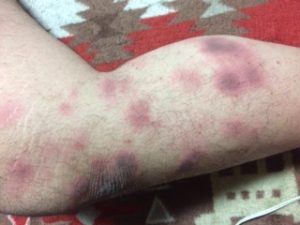
Characterized by oozing and crusting over, this class of rash is oval or round in occurrence and tends to appear over arms and legs of a person.
Cause: Skin infection by bacteria, skin abrasion due to chemicals or poor blood circulation to limbs are some of the reasons to have caused nummular dermatitis.
Stasis dermatitis
Another non-curable skin rash, this category of eczema is identified by discoloured, itchy and thickened skin. Treatment and medical attention can provide temporary relief.
Cause: As the name suggests, it is caused by a collection of fluid in the veins of limbs due to improper blood circulation.
Dermatitis neglecta
The occurrence of dark, dead and itchy skin over various parts of the body typifies this kind of rash.
Cause: Lack of regular personal hygiene leads to accumulation of dirt, sweat and dead skin cells, thereby resulting in flaky appearance and hyperpigmentation of the skin.
Contact Dermatitis
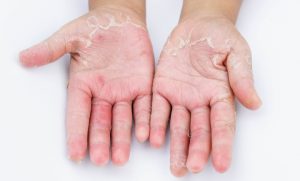
It is a common type of rash where the skin gets irritated and results in redness of the patch. This gets aggravated and turns into fluid-filled blisters. OTC ointments and basic anti-allergic medications might help ease the problem.
Cause: A general exposure to an irritant like fragrance, metal, or skin product may trigger the skin rash.
2. Psoriasis
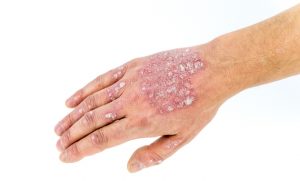
It is a common skin disease that affects joints, scalp and other parts of the body. This is a chronic in nature of the occurrence, i.e. it is incurable. However, timely and proper medical attention and treatment may help in keeping its symptoms under check. While proper care can help keep the disease in remission, even a slight change in conditions, like weather, lifestyle, and diet, or even stress, may lead to its eruption in full blow.
Cause: It is an autoimmune disorder, i.e., the immune system automatically gets activated due to the entry of any external inflammatory agents in the body. Plaques of thickened, scaly skin cells trigger the WBCs to produce certain chemicals responsible for the rapid proliferation of skin cells in the area. It is the over-production of the skin cells and their accumulation in a specific area that provides redness and scaly appearance to the rash.
3. Dermatitis Medicamentosa (Drug eruptions)
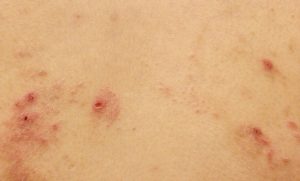
The rash may vary in its appearance from being simply red to be fluid filled and utterly painful and itchy.
Cause: An allergic reaction to a drug, like antibiotics, may cause such an eruption. The intensity of the rash depends on the extent of inflammatory response generated to a dug ingested.
4. Swimmer’s itch (cercarial dermatitis)
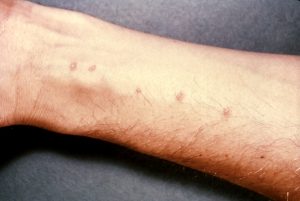
It is the appearance of small red itchy blisters on the skin of a swimmer that might provide a burning sensation.
Cause: Exposure to contaminated water which contains a huge number of microscopic parasites. These come in contact with a swimmer ( and so is the name) and cause the rash.
5. Heat rash (Miliaria)
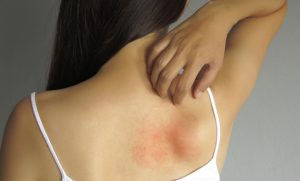
The prickly rash during hot and humid weather that occurs due to clogged pores in the skin is miliaria. This can be treated by use of common antifungal dusting powders and OTC ointments, wearing light cotton clothing and keeping the skin fresh and clean.
Cause: Dirt, sweat and dead skin cells lead to blocked sweat ducts that results in leakage of sweat into the epidermal or dermal layer of the skin. This causes redness and itchiness on the skin.
6. Intertrigo (Intertriginous dermatitis)

It is characterized by the occurrence of itchy rash where the skin burns and gets inflamed due to sweat and microbial growth, particularly in the areas of skin folds, like underarms or below the knees. This can worsen and appear to be prickly and painful for the patient later on.
Cause: Heat and moisture, lack of exposure to air, or friction might induce the inflammatory response in the skin. This can be aggravated by any microbial growth in the particular area.
7. Rosacea
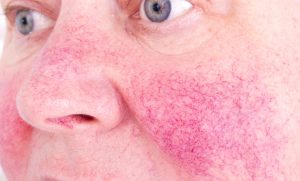
Rosacea erupts in the form of small red rashes, and rarely as pustules, especially on the cheeks and chin. Rosacea heals spontaneously and no treatment is required for resolution. However, symptomatic relief can be given with the help of some medications. Redness over the face, visible blood vessels and swollen nose are the common symptoms to distinguish it from acne and other allergic reactions.
Causes: Unhealthy food and an unstable lifestyle may be a major cause of the occurrence of the rash. In case of a family history, the problem is likely to occur with an increased probability.
8. Chickenpox
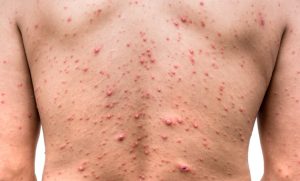
Though it occurs in less than 1 million population of our country per year, owing to the availability of vaccination in the infancy, the disease can spread easily because of its highly contagious nature. It is characterized by the occurrence of small, red and itchy rashes over the body that gets filled with fluid over the time.
Cause: Infection caused by varicella virus causes redness and fluid-filled rashes all over the body. Coming in contact with an infected person, like fluid oozing out of the blisters, sneezing or coughing, can spread the virus. Even the crust of the dried blisters is potent enough to spread the infection.
9. Tinea (ringworm)
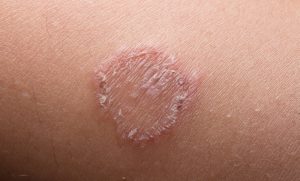
The appearance of small, ring-shaped or circular rash causing red patches on the skin is the characteristic of a tinea infection. It is called ringworm because of the occurrence of a ring-like circular pattern of the rash.
Cause: Oil, dirt, sweat or a weak immune system may lead to fungal growth on the skin surface
10. Razor bumps
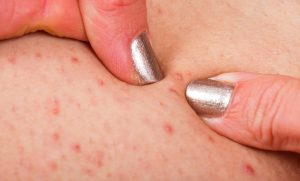
Clusters of small dark bumps or patches occur around the hair follicle, particularly on the face, pubic area, or underarms. This generally happens after a hair removal routine. The area turns red and may experience itchiness or burning sensation.
Cause: When a hair strand tends to curl back into the follicle instead of growing out of it, it causes inflammation in the area, resulting in pain or pustule formation.
11. Athlete’s foot
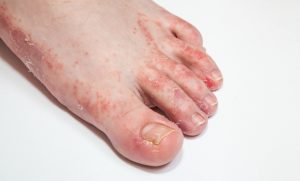
It is the inflammation of the skin between the toes. Scaly red rash erupts, that often gets fluid filled resulting in small and painful blisters.
Cause: Sweat and dirt favor fungal growth in feet that are covered most of the time in shoes. Further, it is a highly communicable disease, and therefore, the risk of contracting the disease increases if one is sharing socks, shoes, towels or any other wearable with an infected person. Even entering a shower or swimming pools barefoot may increase the likelihood of an infection, as these are the storehouse of the fungus that causes the infection.
12. Hives
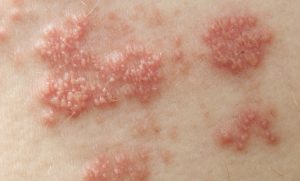
Red and itchy welts may occur on any part of the body. However, the most peculiar fact about hives is that they are dynamic in nature. In other words, this kind of rash changes its size, shape and position over the body in short intervals of time.
Cause: Stimulation of inflammatory response, i.e., the release of histamines in the body in response to Common stimulants, e.g. a particular food item or an environmental factor like sunlight.
13. Impetigo
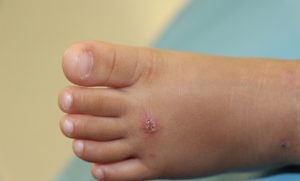
These are the red sores that appear on the face, near mouth and nose, commonly occurring in infants and children. These get fluid filled, ooze out and turn yellow-brown and crusty in a few days.
Cause: Bacterial infection near mouth and nose causes such a rash. This is highly contagious and can spread through contact with an infected person.
14. Herpes Zoster (Shingles)
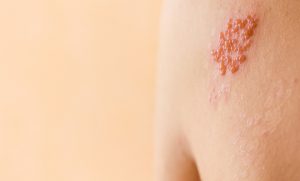
It generally occurs at one side of a body part-the torso of a person or near face and ears. It is a red rash, characterized by the occurrence of fluid-filled blisters. These can break easily, contributing to the pain and burning sensation associated with it.
Cause: Reactivation of varicella-zoster virus, the chickenpox virus, at the adult stages of life.
15. Bites and Stings
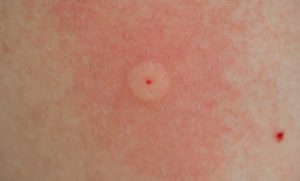
The rash is identified by redness, swelling and pain in the affected area. Nevertheless, some of the bites have life-threatening effects; most the bites have short-lived effects and heal with time.
Cause: Bite or sting of an insect, wasp, yellow jacket or bee. This is, generally, non-communicable in nature.
16. Measles
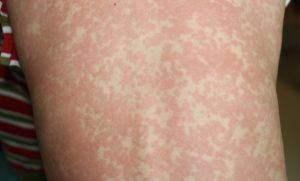
Characteristic red itchy rashes initially appear over the head, thereafter spreading to the entire body of a person. Other complimentary symptoms that distinguish the rash from any other type described earlier are- cough, runny nose, fever and general body weakness.
Cause: Acute viral infection of the respiratory tract causes measles. It is highly contagious in nature and can easily spread through contact.
17. MRSA (staph) infection
The occurrence of sores or boils on the skin, with other symptoms like an infection of blood or urinary tract, are the related to MRSA infection.
Cause: As the name suggests, MRSA or Methicillin-resistant Staphylococcus aureus (a bacterium) is resistant to many antibiotics, and may cause infection to many parts of the body
An early and timely diagnosis of skin rash can result in proper and an effective treatment. Physical examination by an expert, followed by any clinical diagnosis and a comprehensive treatment plan can be drawn out only if you are aware enough of your body. This saves a person from lifelong trauma, and facilitate a healthy and happy environment to thrive.
5,265 total views, 2 views today
